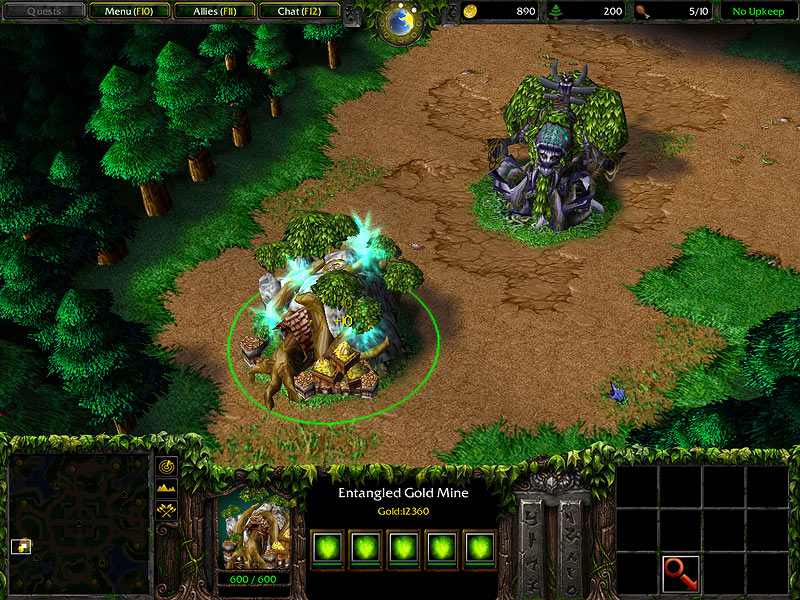Divide And Destroy V 5 7 Warcraft 3

Every Sunday, we dust off one of our favourite articles from the archive for you to enjoy again or maybe read for the first time. As Hearthstone goes into open beta and Blizzard sits on the cusp of another potential phenomenon, we thought we'd go back to November 2009, as World of Warcraft celebrated its first five years.
World of Warcraft celebrated its fifth anniversary last week. On 23rd November 2004, Blizzard launched its MMO in North America. Even though some critical features (player-versus-player battlegrounds, for one) weren't implemented, the game clearly outstripped established rivals in polish and scale at launch, and demand was so intense that Blizzard's overloaded servers spent the first few months fighting a losing battle against the tide of players.
So you can hardly call Blizzard's first steps in massively multiplayer gaming tentative. Nevertheless, WOW in its early days was a shadow of what it has become over the last five years, in terms of the quality of the game itself as well as the size of its player-base (two million in June 2005, 12 million today) and its impact on popular culture. You can trace that journey on this site: in and in reviews (the, the, the reviews of the and expansions). Best of all, you can hear the story of its development in the words of its developer, in parts and of our exclusive Making of World of Warcraft. But some of that story can only be understood, and properly put into context, in hindsight. You'd need a book to comb over the significance of every event, so below we single out one development in the game and one in real life ['IRL', surely -Ed] for each of WOW's five years of operation.
Version: 2.0. Split a stack with just one click when you click on one of the numbered buttons (OK(1),2,3,4,5,6,7,8,9,10 and 20). Split is placed on the cursor, so you can place it in a slot, trade, buy, destroy or what ever.
Some of them are famous, some obscure; it's not a definitive list and they might not be the single most important moments in WOW's history, but they all say something about where the game has been, how far it's come, and how much it's changed the gaming landscape. 2005 in-game: Corrupted Blood It was a simple mistake, a piece of deliberate design that somehow escaped its parameters and ran amok. In September 2005, patch 1.7: Rise of the Blood God introduced the raid dungeon Zul'Gurub. Final boss Hakkar would infect players with a disease called Corrupted Blood that would damage them over time, and jump to other nearby players.
It was a feature of the boss fight, nothing more. It was never intended to leave the safe confines of the instance. Cinema 4d plugins pack. On some servers, players exploited teleportation to carry Corrupted Blood from Zul'Gurub's remote jungle location to the game's major urban centres. It spread like wildfire, killing lower-level characters in seconds. Regular gameplay was completely disrupted; some players took malicious glee in spreading it, while others formed an impromptu relief effort, taking it upon themselves to heal the sick. Eventually, Blizzard was forced into a hard reset of affected servers to kill it off.
The has since been used as a study on the spread of real-world epidemics - which it closely resembles - and has even invited comparisons to terrorism in the way some players chose to spread it. It was such a dramatic event that Blizzard sought to replicate it, notably with the zombie plague that heralded the launch of second expansion Wrath of the Lich King. But truth be told, it was the first and last time that WOW's world of Azeroth would really take on a life of its own. Stories like this are more closely associated with less regulated 'sandbox' MMOs like EVE Online. Blizzard, ever the control freak, the meticulous director of player experiences, might have sought to mimic Corrupted Blood under controlled circumstances, but it could never allow it to happen again. The fix was in.
 CEEOL provides scholars, researchers and students with access to a wide range of academic content in a constantly growing, dynamic repository. Currently, CEEOL covers more than 2000 journals and 480.000 articles, over 2200 ebooks and 2500 grey literature document. Currently, over 1000 publishers entrust CEEOL with their high-quality journals and e-books. CEEOL offers various services and their patrons to make access to its content as easy as possible.
CEEOL provides scholars, researchers and students with access to a wide range of academic content in a constantly growing, dynamic repository. Currently, CEEOL covers more than 2000 journals and 480.000 articles, over 2200 ebooks and 2500 grey literature document. Currently, over 1000 publishers entrust CEEOL with their high-quality journals and e-books. CEEOL offers various services and their patrons to make access to its content as easy as possible.